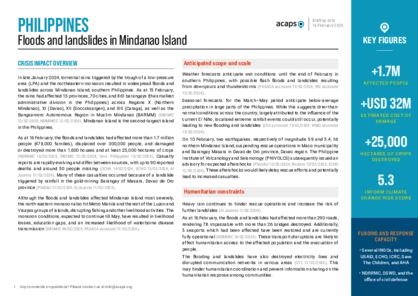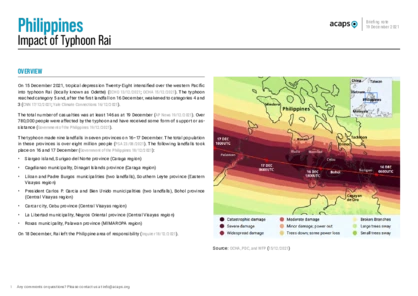Latest updates on country situation
05 November 2025
Typhoon Kalmaegi, locally named Tino, struck central Philippines on 4 November 2025, making it the 20th tropical storm to hit the country this year. There are 66 confirmed deaths, with 26 still missing. Most casualties are in Cebu province, which was still reeling from a magnitude-6.9 earthquake in late September. The typhoon has displaced around 400,000 people, with floodwaters submerging homes and vehicles. Residents have been stranded awaiting rescue on rooftops. Communication, transport, and power systems have been disrupted, with flights and ferries cancelled and debris and floodwaters blocking roads and bridges, isolating communities. The cyclone has compounded the impacts of previous storms and the earthquake, increasing needs. Little information is available on the needs of those affected, but critical priorities likely include immediate search-and-rescue operations, emergency shelter provision, WASH support, and the urgent restoration of logistics networks to enable relief delivery. (BBC 05/11/2025, AJ 04/11/2025, The Guardian 03/11/2025)
14 October 2025
On 10 October 2025, a magnitude 7.4 earthquake struck Manay municipality, Davao Oriental, followed by a magnitude 6.8 aftershock. The tremors triggered landslides and ground fissures, prompting panic evacuations as tsunami alerts forced thousands to flee coastal areas. By 14 October, the National Disaster Risk Reduction and Management Council estimated that over 845,000 people were affected, with nearly 13,000 still displaced and staying in evacuation centres or with relatives. More than 1,000 aftershocks have destabilised structures, heightening safety concerns and adding damage to homes, bridges, schools, and health facilities. Based on past experiences, the most urgent needs for displaced populations likely include shelter and WASH support. Authorities have declared states of calamity, and national response teams alongside humanitarian responders are intensifying rescue and relief operations to reach remote and intensely affected communities, although aftershocks and disrupted access continue to pose serious challenges for relief efforts. (NDRRMC 14/10/2025, AJ 10/10/2025, Reuters 10/10/2025)
06 October 2025
On 30 September 2025, a magnitude 6.9 earthquake struck northern Cebu province, causing severe humanitarian impacts across the province. By 8 October, at least 72 people had died, 559 were injured, and more than 699,000 were affected. The quake affected 62,531 houses (4,854 destroyed, 57,677 damaged) and 733 critical infrastructure sites, including schools and hospitals. Over 6,900 have been displaced – likely an underestimation considering the number of houses damaged or destroyed. More than 3,600 aftershocks, as well as power outages and landslides, are impeding relief operations and access to remote communities. Damage to infrastructure and transport networks continues to hamper the delivery of food, medicine, and relief supplies. Residents face critical shortages of safe water and sanitation, and health authorities warn of increased risk of waterborne diseases. States of calamity have been declared in affected municipalities, with national and humanitarian responses underway. (NDRRMC 08/10/2025, OCHA 03/10/2025, IFRC 05/10/2025)
29 July 2025
Tropical storm Co-May struck northern Luzon on 24–25 July, first making landfall in Agno, Pangasinan province, then in Ilocos Sur province as it weakened. Cyclone Wipha had hit the country only a week earlier. The combined effects of these hazards caused at least 25 deaths, mainly from flash floods, landslides, electrocution, and falling trees. Eight people were reported missing. The tropical storm worsened the impact of the southwest monsoon (Habagat), causing extensive flooding and landslides. By 25 July, 278,000 people were evacuated and nearly 3,000 homes damaged, with over 3 million people affected nationwide. Schools and offices were closed across Manila and Luzon, and at least 77 towns declared a state of calamity. Urgent needs for the affected people are yet to be assessed, although a government response is underway. Moderate to heavy rainfall is anticipated for the last three days in July in the northern Philippines, potentially aggravating the situation. (ECHO accessed 28/07/2025, The Watchers 25/07/2025, mid-day 25/07/2025)
19 November 2024
Six typhoons have ravaged the Philippines in less than a month since late October 2024, affecting more than ten million people in 17 of the 18 regions in the country. The typhoons have caused heavy rains, strong winds, widespread flooding, and landslides. Nearly 900,000 people need humanitarian assistance after facing the impacts of Typhoons Trami, Kong-rey, and Yinxing, with the humanitarian toll of the three most recent typhoons (Toraji, Man-yi, and Usagi) still yet to be assessed. By 20 November, nearly 800,000 people were internally displaced (although the majority of these displacements are expected to be temporary), and more than 200,000 houses have been damaged and 21,000 destroyed. (HCT Philippines/OCHA 12/11/2024, DSWD 20/11/2024 a, DSWD 20/11/2024 b)
29 October 2024
On 24 October 2024, Typhoon Trami made landfall in Luzon, Philippines. The typhoon brought severe winds and heavy rains and caused floods and landslides across the country, exposing over seven million people to the impacts. By 29 October, the disaster had killed nearly 140 people, with more still missing. Around 600,000 people are internally displaced, 160,000 of whom are residing in evacuation centres. Around 93,000 houses have been damaged and 6,000 destroyed, while around 35,000 hectares of cropland have been damaged and 25,000 destroyed. The typhoon has affected around 65,000 farmers and fisherfolk. Damage to road, telecommunications, power, and water supply infrastructure has been reported. Affected people urgently need food, potable water, shelter, healthcare support, and NFIs, such as clothes, cooking kits, hygiene kits, flashlights, and solar lamps. (DSWD 29/10/2024, NDRRMC 29/10/2024, OCHA 28/10/2024)
10 September 2024
The combined effects of Severe Tropical Storm Yagi and the southwest monsoon since early September 2024 have exposed the Philippines to heavy rains, flooding, and landslides. By 10 September, the impact had displaced around 71,000 people, most of whom were staying with their relatives or friends, while others were at evacuation centres. Most of the displaced are in Bicol, Calabarzon, and Central Luzon regions. Successive storms and heavy rains since July have given the affected people inadequate time for recovery. These climate events have damaged at least 15,000 houses, destroyed 2,100, rendered 30 roads and seven bridges impassable, destroyed around 23,000 hectares of crop area, and damaged around 77,000. The affected people need food, potable water, healthcare support, hygiene kits, and kitchen kits. Affected farmers and fisherfolk require livelihood support. Although state and non-state humanitarian response is underway, the affected people still need assistance. (NDRRMC 10/09/2024, NDRRMC 26/08/2024, DSWD 11/09/2024)
current crises
in
Philippines
These crises have been identified through the INFORM Severity Index, a tool for measuring and comparing the severity of humanitarian crises globally.
PHL019 - 2025 Earthquake in Regions VII, XI and XIII
Last updated 28/11/2025
Drivers
Earthquake
Crisis level
Country
Severity level
1.9 Low
Access constraints
2.0
PHL018 - 2025 Southwest Monsoon Floods and Cyclones
Last updated 28/11/2025
Drivers
Floods
Cyclone
Crisis level
Country
Severity level
2.9 Medium
Access constraints
2.0
PHL001 - Country level
Last updated 28/11/2025
Drivers
Conflict/ Violence
Cyclone
Floods
Crisis level
Country
Severity level
3.1 High
Access constraints
2.0
PHL003 - Conflict in Mindanao
Last updated 28/11/2025
Drivers
Conflict/ Violence
Crisis level
Country
Severity level
2.1 Medium
Access constraints
2.0
Active risks
Analysis products
on
Philippines
13 November 2024
The Philippines: Impact of Tropical Cyclone Trami (Kristine) and Kong-rey (Leon)
DOCUMENT / PDF / 481 KB
By 11 November, Trami and Kong-rey had affected over 9.6 million people in 17 of the country’s 18 regions. By 12 November, there were nearly 893,000 people in humanitarian needs. By 31 October, a total of 160 cities and municipalities across the country had declared a state of calamity.
13 August 2024
Phillipines: increased risk of disease outbreaks following typhoons
DOCUMENT / PDF / 705 KB
On 20 July 2024, Typhoon Prapiroon (Butchoy) brought heavy rains to several of the Philippines’ municipalities, marking the beginning of the southwest monsoon (Habagat), followed by the more devastating ‘super’ Typhoon Carina (Gaemi) on 21 July.
16 February 2024
Philippines: floods and landslides in Mindanao Island
DOCUMENT / PDF / 985 KB
In late January 2024, torrential rains triggered by the trough of a low-pressure area (LPA) and the northeastern monsoon resulted in widespread floods and landslides across Mindanao Island, southern Philippines.
19 December 2021
Philippines: Typhoon Rai
DOCUMENT / PDF / 217 KB
On 15 December 2021, tropical depression Twenty-Eight intensified over the western Pacific into typhoon Rai (locally known as Odette). Over 780,000 people were affected by the typhoon and have received some form of support or assistance. 400,000 people require urgent relief and long-term support.






